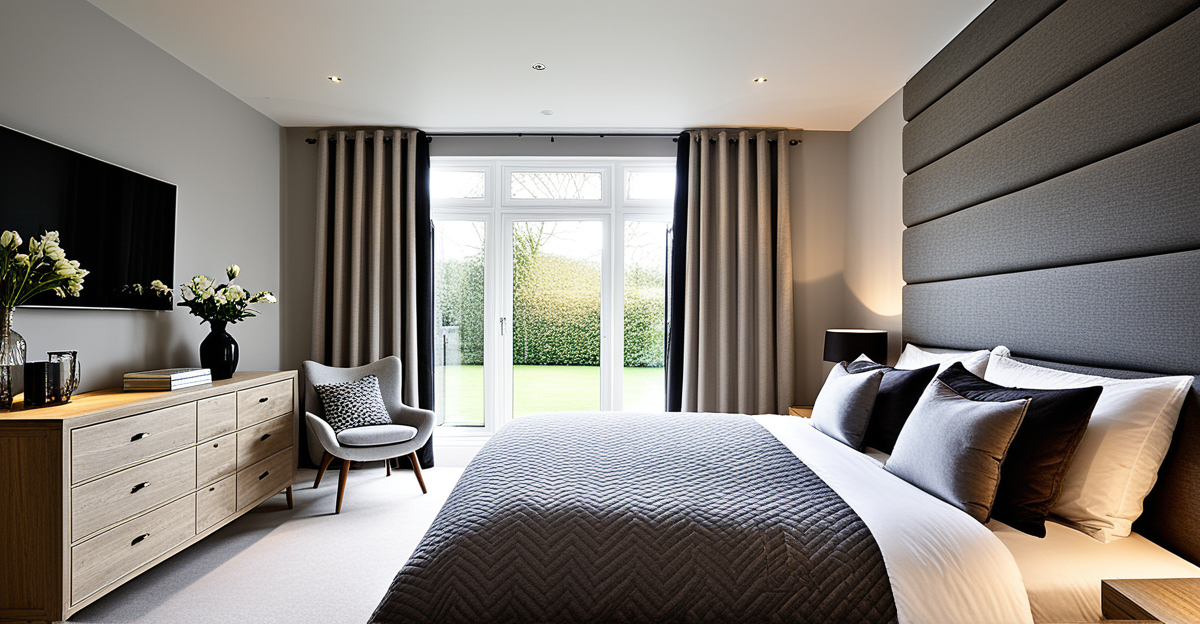Functional Layouts for Small UK Bedrooms
When tackling bedroom space planning in the UK, especially for small bedrooms, mastering the functional layout is crucial. The key is to optimise floor plans even when rooms have awkward shapes or limited dimensions. For example, positioning the bed to one side can free up valuable floor space, increasing movement and comfort.
Making the most of corners and vertical space is essential in small UK bedrooms. Installing wall-mounted shelves or corner cabinets utilises often neglected areas, while tall wardrobes or hanging storage taps into vertical room without crowding the floor. This efficient design strategy keeps necessities organized and accessible without cluttering the space.
In parallel : How Can You Enhance Your Comfort with Simple UK Home Living Tips?
Arrangement strategies also play a pivotal role in small bedroom design. Placing furniture against walls creates an open central area, which enhances the feeling of spaciousness. Choosing furniture that fits the room’s scale ensures the layout promotes ease of movement, making the bedroom both practical and inviting.
In sum, successful UK bedroom layouts focus on smart positioning, vertical utilisation, and careful choice of furnishings to make compact rooms both livable and comfortable. Applying these functional concepts unlocks the potential even in the smallest UK bedroom designs.
Have you seen this : How Can You Transform Your Home’s Ambiance with Minimal Changes?
Smart Storage Solutions Tailored to UK Homes
Maximising storage in small UK bedrooms is vital for maintaining a clutter-free environment that feels spacious and comfortable. Built-in wardrobes are a prime example of efficient space-saving storage. These wardrobes fit flush against walls, reducing wasted gaps and using vertical space to store clothes, shoes, and accessories neatly.
Under-bed storage UK solutions are also invaluable for small bedroom design. Drawers or containers fitted beneath the bed provide hidden compartments that keep rarely used items out of sight yet easily accessible. This method leverages otherwise unused space, perfect for compact rooms where every inch counts.
Space-saving storage extends beyond wardrobes and under-bed options. Multi-purpose furniture with integrated storage, such as ottomans with compartments or beds with headboards containing shelves, offers flexibility without overcrowding the room. These pieces seamlessly blend storage with function to support an organised and efficient UK bedroom layout.
Innovative ideas like customised shelving units or corner cupboards optimise awkward spaces prevalent in many UK homes. Smartly designed storage, tailored to room shape and size, enhances small bedroom design by ensuring that belongings are stored properly while maintaining ease of movement and comfort.
Functional Layouts for Small UK Bedrooms
Careful bedroom space planning is the foundation for effective small bedroom design in the UK. When faced with compact or awkwardly shaped rooms, optimising the floor plan means prioritising functionality without sacrificing comfort. One proven method involves placing larger pieces, like beds, against longer walls to open up central space for movement.
Utilising corners smartly is another vital strategy—corner desks or wardrobes fit neatly without intruding on walkways. Similarly, vertical space usage is indispensable. Tall wardrobes or shelving units take advantage of room height, freeing floor area and maintaining an uncluttered feel in the UK bedroom layout.
Arrangement strategies should also aim to maximise both movement and comfort. Keeping furniture away from doorways and ensuring ease of access to storage enhances the flow. Selecting appropriately sized furniture prevents overcrowding; oversized pieces can stifle the openness desired in small bedrooms.
In sum, a successful UK bedroom layout for small rooms balances strategic positioning, corner and vertical utilisation, and scaled furnishings. This holistic approach allows even compact spaces to feel roomy, functional, and inviting—perfectly aligning with the needs of modern UK bedrooms.
Functional Layouts for Small UK Bedrooms
Effective bedroom space planning in small UK bedrooms demands creative solutions for awkward or compact areas. A fundamental tactic is optimising the floor plan by placing larger furniture, such as beds, against longer or less obstructed walls. This clears central floor space, promoting freedom of movement in otherwise tight rooms.
Corners provide valuable yet often underused zones for storage or workspace. Incorporating corner wardrobes or desks utilises these nooks without hindering accessibility. Equally important is leveraging vertical space—tall wardrobes and shelving units enable storage expansion without sacrificing floor area, which is essential in compact UK homes.
Arrangement strategies focus on eliminating clutter and maximising comfort. Positioning furniture away from doorways and windows improves natural light flow and makes navigation easier. In addition, selecting furniture that matches the scale of the room helps avoid overcrowding, enhancing the sense of openness fundamental to successful small bedroom design.
In brief, an effective UK bedroom layout blends smart positioning, corner utilisation, and vertical design to transform compact spaces into comfortable, functional bedrooms that suit modern living standards.
Functional Layouts for Small UK Bedrooms
Effective bedroom space planning for small UK rooms requires innovative approaches to optimise often awkward or compact floor plans. Placing larger furniture against longer walls immediately opens up central areas, improving circulation and comfort. This tactic is a cornerstone of practical UK bedroom layout design.
Making the most of corners is equally critical. Corner wardrobes or desks neatly fit into niches, transforming unused space into functional storage or work areas without reducing movement pathways. Coupled with vertical space utilisation—such as tall shelving and wardrobes—this strategy ensures storage needs are met without overcrowding the room.
Arrangement also plays a vital role in maximising comfort. Keeping furniture away from doorways and windows maintains natural light and ease of access, essential in small bedroom design. Choosing appropriately scaled furnishings avoids the cramped feeling oversized pieces can cause, enhancing the room’s openness.
In summary, successful small bedroom design focuses on intelligent positioning, corner and vertical space use, and mindful furniture arrangement. This approach transforms tight UK bedrooms into comfortable, functional retreats that meet modern living expectations.




